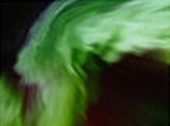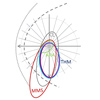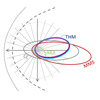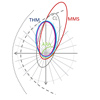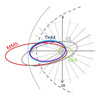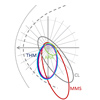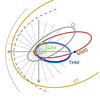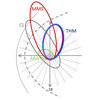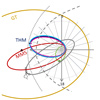Orbits
The five THEMIS spacecraft (probes) were placed in highly elliptical orbits where the spacecraft line up at apogee every four days. The apogee rotates slowly around the Earth to cover the dayside, dawnside, nightside, and duskside of the magnetosphere. Initially, right after launch in 2007, the 5 THEMIS spacecraft were lined up in the same orbit. Since 2011, P1 and P2 have become ARTEMIS and orbit the moon, while the 3 remaining Earth-orbiting THEMIS probes are able to synergize observations with other Heliophysics System Observatory (HSO) missions such as Van Allen Probes (VAP), Magnetospheric Multiscale (MMS), CLUSTER (CL), Geotail (GT) and Arase (ARA).
In the dusk science phase the apogee of P3, P4, and P5 are approximately 13 Re. THM-MMS-CLUSTER in clustered orbits.
In the tail science phase the apogee of P3, P4, and P5 are approximately 13 Re. THM-MMS-CLUSTER in clustered orbits, to study nightside reconnection.
In the dawn science phase the apogee of P3, P4, and P5 are approximately 13 Re. THM-MMS-CLUSTER in clustered orbits.
In the dayside science phase the apogee of P3, P4, and P5 are approximately 13 Re. THM-MMS-CLUSTER in clustered orbits, to study dayside and foreshock phenomena.
In the dusk science phase the apogee of P3, P4, and P5 are approximately 13 Re. THM-MMS-CLUSTER in clustered orbits.
In the tail science phase the apogee of P3, P4, and P5 are approximately 13 Re. THM-MMS-CLUSTER on resonant orbits, to study the drivers and consequences of tail reconnection.
In the dawn science phase the apogee of P3, P4, and P5 are approximately 13 Re. THM-MMS-CLUSTER in clustered orbits. THM explores magnetopause reconnection in response to drivers from foreshock transients.
In the dayside science phase the apogee of P3, P4, and P5 are approximately 13 Re. MMS is also in the dayside. THM-MMS on resonant orbits, to study the kinetic/regional drivers of reconnection at the magnetopause.






